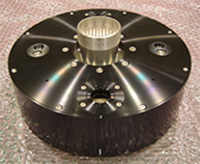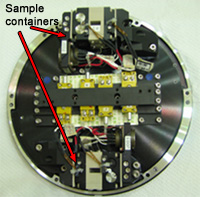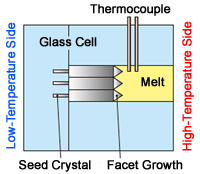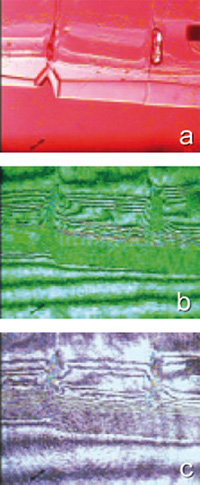This is an archive of information released in the past.
Disclaimer: It may contain broken links or outdated information. Some parts may not function in current web browsers.
*Visit https://humans-in-space.jaxa.jp/en/ for the latest information.

Experiment
- News
- Kibo Utilization Strategy
- Kibo Utilization Plan
- List of JAXA's Utilization Themes
- Experiment Facilities
- Space Environment Utilization
- Archive
News
- FACET Experiment Performed (September 1, 2010)
Background and Objectives

Figure 1. A Rock Crystal (Left) and Agate Crystal (Right)

Figure 2. Growth of Faceted Crystal Over Time
The close observation of a rock crystal with a regular hexagonal cylindrical structure shows that it has flat surfaces. Crystals of salt and agate also have such a flat surfaces (Figure 1). Such flat surfaces are known as “facets”. Facets consist of layers of molecules and atoms -molecules of silicon oxide in the case of a rock crystal. Some materials used for electronic devices and optical elements grow by “facet growth” (Figure 2), in contrast with snow and ice crystals, which form a branch-like structure.
Crystal growth process is very complicated. In particular, very little is known about facet growth, including the factors affecting it and the conditions under which it progresses. Since it is well known that crystals tend to develop structural defects and capture impurities when a new facet is generated, it is necessary to examine the facet growth process to grow high-quality semiconductors and superconductors. This study may also contribute to the creation of new functional materials.
Vertical up- and downflows of water or air are respectively generated by heating a kettle of water on a fire or by turning on a heater in a room. Such a flow is called “buoyant convection”, and is due to the force of gravity acting on water or air whose density has been changed by heating. Buoyant convection is an unavoidable phenomenon on Earth and disturbs the growth environment during the crystal growth process. Therefore, the precise observation of the facet growth process requires experiments in an environment without buoyant convection caused by gravity.
A mixture of salol (phenyl salicylate) and butanol is used for this experiment as a model material. Since a melt of this mixture is optically transparent with a low melting point, it is suitable for the in-situ observation of the facet growth.
Experiments

Figure 3. Appearance of the Facet Cell

Figure 4. View of Inside the Facet Cell

Figure 5. Cross-Section of the Glass Container Used for the Crystal Growth Experiment
The solution crystallization observation facility (SCOF) is used for this experiment. An image of the facet cell developed for this experiment is shown in Figure 3, and a view of inside the facet cell is shown in Figure 4. First, the sample is enclosed in a sample container made of thin glass (Figure 5), and then a temperature difference is generated between both sides of the container so that the facets can grow. The crystal growth process is observed by an amplitude modulation microscope using light transmitted by the facet cell (Figure 6(a)). This microscope is suitable for precise observation of the shape of crystals. A Mach-Zehnder interference microscope is used to measure changes in the temperature and concentration of the butanol, which are displayed in the form of counter lines (Figures 6(b) and (c)), using the interference of light, on the basis of the phenomenon that the refractive index changes with the concentration and temperature of the melt. This interferometer enables us to precisely measure the temperature and concentration around the crystals when a new facet appears.
If the factors affecting facet growth are elucidated by this experiment, it may be possible to theoretically explain the process of facet growth, then its application to actual material manufacturing processes can be expected. This would also deepen the understanding of the formation process of natural minerals with facets such as rock crystal and agate.
Main Points of This Experiment !

Figure 6. Crystal Facets Observed by an Amplitude Modulation Microscope (a) and Mach-Zehnder Interference Microscope (b) and (c)
Detailed Observation and Deep Understanding
Detailed observation of the crystal growth process in microgravity is expected to deepen our understanding of facet crystal growth.
Contributing to the Creation of High-Quality Crystals.
To improve the performance of electronic devices, it is necessary to grow crystals without defects and impurities, particularly those of oxide superconductors and semiconductors. Examining the facet crystal growth process is expected to contribute to the creation of high-quality crystals. One possible application is the efficient production of polysilicon used for solar battery panels, which could contribute to the widespread use of clean energy. It may also be possible to improve the performance of superconductors, contribute to establishing a means of faster mass transportation, and to expand information and telecommunication networks including cellular base stations.
Organization
 |
Principal Investigator (PI)
Yuko INATOMI Associate Professor, Institute of Space and Astronautical Science, Japan Aerospace Exploration Agency |
| Copyright 2007 Japan Aerospace Exploration Agency | Site Policy |